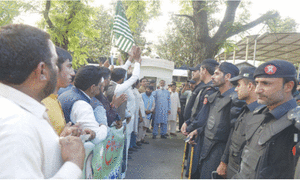NAWABSHAH, April 18: An acute shortage of doctors, paramedics and healthcare facilities and prolonged absence of posted staff in the government-run health care units and hospitals in the district have aggravated problems for the poor patients who can not afford expensive treatment in private clinics.
Sources in the health department disclosed on Friday that around 143 posts including 95 in BPS-16 and above and 48 posts from BPS-1 to 15 were vacant.
The shortage of doctors, paramedics and technicians has made it almost impossible to provide health facility to people in the far-flung rural areas.
There are growing complaints about prolonged absence of doctors and paramedics and negligence in duty. Members of civil society have sent several requests to Sindh Health Department asking it to fill vacant posts but the department has not so far taken any decision probably due to political considerations.
The department had initiated a public-private partnership programme under which Basic Health Units, Rural Health Centres and dispensaries had been handed over to private parties in various districts except Nawabshah.
There are 34 BHUs, nine RHUs, two mother and child care centres, 24 dispensaries, a taluka hospital and a leprosy centre working under the EDO of health in the district.These vacant posts of BPS-16 and above include a district health officer administration, a district dental officer, a field supervisor, a taluka health officer, two medical superintendents, two chief women medical officers, a DDO of administration, a DDO of HRD, a DDO of procurement, a DDO of planning, a deputy taluka health officer curative, a deputy taluka health officer procurement, 12 senior medical officers, six senior women medical officers, two senior dental surgeons, two anaesthetists, two ophthalmologists, a gynaecologist, a pathologist, a physician, a skin specialist, a DDO preventive, a DDO curative, a planning officer, 33 medical officers, nine women medical officers, six dental surgeons and a procurement officer.
The 48 vacant posts in BPS 1-16 include eight health inspectors, an assistant health inspector, a paramedical tutor, three lady health visitors, seven health technicians, two X-ray technicians, five dispensers, four midwives, three vaccinators, three drivers, seven ward servants, five Dais, a bearer, a Naib Qasid and a watchman.
Sources said that most of the doctors were busy doing private practice and rarely attend the government-run centres where they were posted while the women medical officers were reluctant to perform duties in rural areas. Most of the time they evaded duties in connivance with the EDO of health office, they said.
A health official said on condition of anonymity that the female medical officers did not go to the centres in rural areas either due to political pressures or for fear of travelling alone in public transport.












































